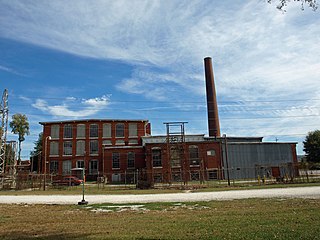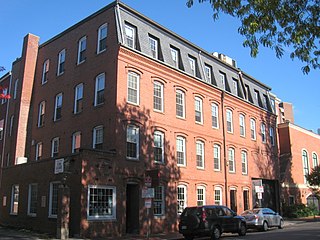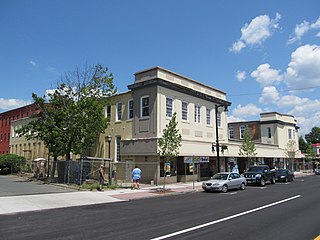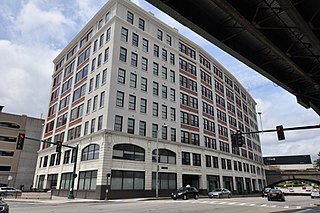
The Bemis Mill is a historic former industrial building at 1-3 Bridge Street, in the village of Nonantum, in Newton, Massachusetts. It is now a general office building called the Meredith Building. The building is significant historically as a surviving early industrial building in the city, and for the remnants of unique power distribution and water control facilities that survive. On September 4, 1986, it was added to the National Register of Historic Places.

Lowe Mill is a former cotton mill of approximately 171,000 sq ft (15,900 m2) located southwest of downtown Huntsville, Alabama.

The Reversible Collar Company Building is a historic factory building at 25–27 Mt. Auburn & 10–14 Arrow Streets in Cambridge, Massachusetts. The building has a complex construction history, consisting of several buildings constructed separately between 1862 and 1907, and gradually combined into a single structure. The oldest portions were built by Allen and Farnham, a printing business. The property was sold to the Reversible Collar Company in 1867, which expanded the facility. The company at first manufactured paper shirt collars, but later also produced paper and paper-fabric combinations for use in products like wall charts and maps. The buildings on the site were sold to the Boston Bookbinding Company in 1897. In the late-1960s the building was converted to office and commercial space.

The United States Whip Company Complex or "United States Line Company Complex" is a historic factory located in Westfield, Massachusetts. It was owned and operated by one of the whip-making businesses that led Westfield to become widely known as "Whip City". United States Whip, created in 1892 by the consolidation of several local manufacturers, was the world's largest manufacturer of whips. The factory complex was listed individually on the National Register of Historic Places in 1983, and as part of an expanded Westfield Center Historic District in 2013.

The F. A. Whitney Carriage Company Complex Historic District encompasses a major 19th-century industrial complex off 124 Water Street in Leominster, Massachusetts. The complex is one of the best-preserved in the city, and was developed by of its most successful businesses of the late 19th and early 20th centuries. The F. A. Whitney Company, founded in 1858, manufactured baby carriages and related products, and operated here from 1862 to 1952, and was one of the city's major employers. The oldest surviving buildings of its manufacturing complex date to 1872. The district was listed on the National Register of Historic Places in 1988. Most of the complex has been converted into residential use.

The Whitney & Company building is a historic industrial facility in Leominster, Massachusetts. The utilitarian brick four story building was built in 1893, and extended in 1923. It was built by Fred Abbot Whitney and Walther F. Whitney, whose business was the manufacture of boxes, notably paper boxes and satin-lined boxes, used for shipping other products to customers. The site was listed on the National Register of Historic Places in 1989. It has since been converted into residences called the Watermill Apartments.

The Lincoln Motor Company Plant was an automotive plant at 6200 West Warren Avenue in Detroit, Michigan, later known as the Detroit Edison Warren Service Center. The complex was designated a National Historic Landmark in 1978, due to its historic association with World War I Liberty engines and the Lincoln Motor Company. However, the main structures were demolished in 2003 and NHL designation was withdrawn in 2005.

The Russell Industrial Center is an industrial factory turned to commercial complex of studios and shops that is located at 1600 Clay Street in Detroit, Michigan. The Russell Industrial Center is a 2,200,000-square-foot (200,000 m2), seven building complex, designed by Albert Kahn for John William Murray in 1915. It contains studios and lofts and serves as a professional center for commercial and creative arts.

The former Brandreth Pill Factory is a historic industrial complex located on Water Street in Ossining, New York, United States. It consists of several brick buildings from the 19th century, in a variety of contemporary architectural styles. In 1980 it was listed on the National Register of Historic Places.

The Means Street Historic District in the Marietta Street Artery district of Atlanta consists of historic, mostly 19th and early 20th century warehouse and industrial buildings now converted to office space along one block of Means St. between Bankhead and Ponders Aves. Means Street was named for landowner Alexander Means and was plotted in 1869. Warehouses were built in this early industrial corridor, then known as Bellwood, along the railroad line. Mule-pulled trolleys brought workers starting in 1882, and these became electrified in 1894.

The Hillsborough Mills are a historic textile manufacturing complex at 37 Wilton Road in western Milford, New Hampshire, near its town line with Wilton. The oldest buildings of the brick mill complex were built in 1866 as a carpet-making operation. This business failed in 1874, but the complex was acquired by other textile interests, and eventual saw success producing carpet yarns, and blankets for horses and bedding. The mills were closed in 1970, and have since been adapted for other uses. The complex was listed on the National Register of Historic Places in 2014.

The Kimball Brothers Shoe Factory is a historic factory building at 335 Cypress Street in Manchester, New Hampshire. The four-story brick building was built in stages between 1885 and 1900, and was a prototypical structure from which the design of other period shoe factories in Manchester were built. Construction was overseen by Head & Dowst, a builder responsible for a number of area public buildings, including schools and prisons. It was funded by local businessmen seeking to diversify the local economy, and was leased to the Kimball Brothers, a leading shoe manufacturer in Lynn, Massachusetts. The building was listed on the National Register of Historic Places in 1985.

The Kazon Building is a historic industrial building at 50 Marble Street in West Rutland, Vermont. Built in 1929, it is a well-preserved local example of a purpose-built garment factory, built by Louis Kazon, a leading local businessman in that industry. It was listed on the National Register of Historic Places in 2004. It has been converted to mixed office and residential use.

The Maquoketa Company–Clinton Machine Company Administration Building, also known as Building #7: Clinton Engines Corporation Administration Building, is a historic building located in Maquoketa, Iowa, United States. It was listed on the National Register of Historic Places in 2006.

Moquin's Bakery, also known locally as the Biscuit Factory and the National Biscuit Company, is a historic former industrial facility at 78 Rose Street in Burlington, Vermont. Built in 1915 by a local bakery, it was acquired and enlarged by the National Biscuit Company, which operated here until 1969. The building was listed on the National Register of Historic Places in 1997 for its economic and commercial historic significance, and has since then been converted into residences.

The Richmond Underwear Company Building is a historic industrial facility at 65 Millet Road in Richmond, Vermont. Built in 1900, it was the town's first major industrial facility, bringing an economic boom to the town. The factory was used for the manufacture of underwear until 1946, and has seen a variety of industrial and commercial uses since then. It was listed on the National Register of Historic Places in 1992.

The Willard Manufacturing Company Building is a historic factory building at 25 Stowell Street in the city of St. Albans, Vermont. Built in 1896, the building saw industrial uses continuously until 2006, retaining many original early period features. It was listed on the National Register of Historic Places in 2006.

The Osgood Bradley Building is an historic industrial building at 18 Grafton Street in Worcester, Massachusetts. Completed in 1916, the eight-story brick building is notable for its association with the Osgood Bradley Car Company, an early manufacturer of both railroad cars and automobiles. The building was listed on the National Register of Historic Places in 2018.

Motor Wheel Lofts is an apartment building converted from a former industrial building. It was listed it on the National Register of Historic Places in 2007.

The Klingman Lofts is a former industrial building that has been converted to residential use, located at 400 Ionia Avenue SW, in Grand Rapids, Michigan. It was built in stages, beginning in 1895, as a furniture factory, and was formerly known as the Central Furniture Company Factory and the H.E. Shaw Furniture Company Factory. It was listed on the National Register of Historic Places in 2013. The building was renovated into apartment space in 2015.






















